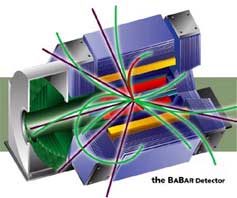

Friday - August 18, 2006
SLAC Today is
available online at:
http://today.slac.stanford.edu
In this issue:
Bs Take an Early Break
Panofsky Fellows Tackle Supernovae and Detector Triggers
Construction Behind Panofsky Auditorium
Symmetry Magazine Highlights LHC
 |
 |
|
Friday - August 18, 2006 |
 Bs Take an Early BreakThe fifth BaBar data taking run came to a close late last night when a small cable fire broke out in Interaction Region 4. The fire started as an experiment aimed at future improvements to the accelerator neared its end, damaging cables in a limited area of the PEP-II ring well away from the BaBar detector, which is located in Interaction Region 2. No one was hurt and all emergency equipment worked properly, containing the fire quickly. The root cause of the fire is not yet clear, but it most likely started near a fan installed to cool a kicker, a component used by the accelerator feedback systems to control the beams. Such a fire is the first of its kind for PEP-II. Investigations into the root cause of the fire will continue today and possibly into the weekend. The shutdown was scheduled to begin Monday morning with a full program of updates and modifications on PEP-II and BaBar. Over the course of the four-month shut down, the BaBar detector and the PEP-II rings are scheduled to see major improvements, along with routine maintenance and safety checks. Read more... |
||
|
|
||
Panofsky Fellows
|
Construction Behind
|
Events (see all | submit)
Access (see all)
Announcements
|
| | ||
|
|
||
 <%
Response.AddHeader "Last-modified", getArticleDate()
'Response.AddHeader "Last-modified","Mon, 01 Sep 1997 01:03:33 GMT"
'Monday, December 06, 2010
%>
<%
Response.AddHeader "Last-modified", getArticleDate()
'Response.AddHeader "Last-modified","Mon, 01 Sep 1997 01:03:33 GMT"
'Monday, December 06, 2010
%>View online at http://today.slac.stanford.edu/. |
||